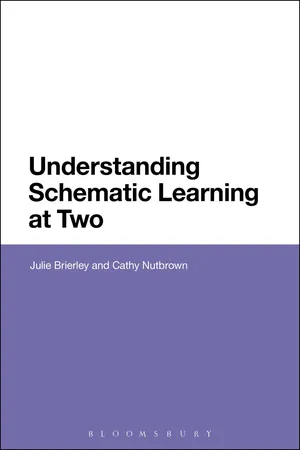
- 208 pages
- English
- PDF
- Available on iOS & Android
Understanding Schematic Learning at Two
About This Book
Providing a deeper understanding of how two-year-old children learn, Understanding Schematic Learning at Two highlights how a schematic pedagogy can be used to recognise and support two-year-old children's thinking and understanding of the world around them. Over a 16-week period four children's individual experiences and stories are constructed, providing detailed written and photographic evidence of the unfolding schematic learning journeys of each. Following the children from nursery setting to their home environments, readers gain a greater understanding of how, even at such a young age, children are intrinsically motivated to select resources from the environment to support their schematic pursuits. The book focuses on the importance of an appropriate environment and informed pedagogy to support two-year-old children's schematic explorations and the significant role adults play in developing these. Beginning by highlighting the important links between learning opportunities, environment and the role of the adults, Brierley and Nutbrown briefly trace the origins of schema and provide an overview of some definitions and characteristics of schemas. This leads to an exploration of how the early years landscape has been influenced through a research, practice and government policy initiatives, concluding that future focus must foreground how children learn. Understanding Schematic Learning at Two highlights how recognising and valuing young children's schemas can provide their supportive adults with the opportunity and ability to acknowledge two-year-old children's capability to actively construct and develop an understanding of the world they live in.
Frequently asked questions
Information
Table of contents
- Cover
- Contents
- List of Figures
- About the Authors
- Acknowledgements
- Introduction
- Part I The Early Years: Research, Policyand Theory
- 1 Young Children as Actors in Their Own Learning
- 2 Schematic Theory
- 3 Early Years Policies and Early Childhood Pedagogies
- 4 The Cultural Nuances of Families’ Lives
- Part II The Stories of Four Young Children’sSchematic Explorations in theirEveryday Lived Experiences
- 5 Containing and Dynamic Vertical Trajectory Schemas: Abby’s Story
- 6 Hannah’s Story: Dynamic Back and Forth, Containing and Enveloping Schemas
- 7 Emily’s Trajectory, Containing, Enveloping and Transporting Schemas
- 8 George’s Going Round a Boundary and Going Through a Boundary Schema
- Concluding Thoughts
- References
- Author index
- Subject index